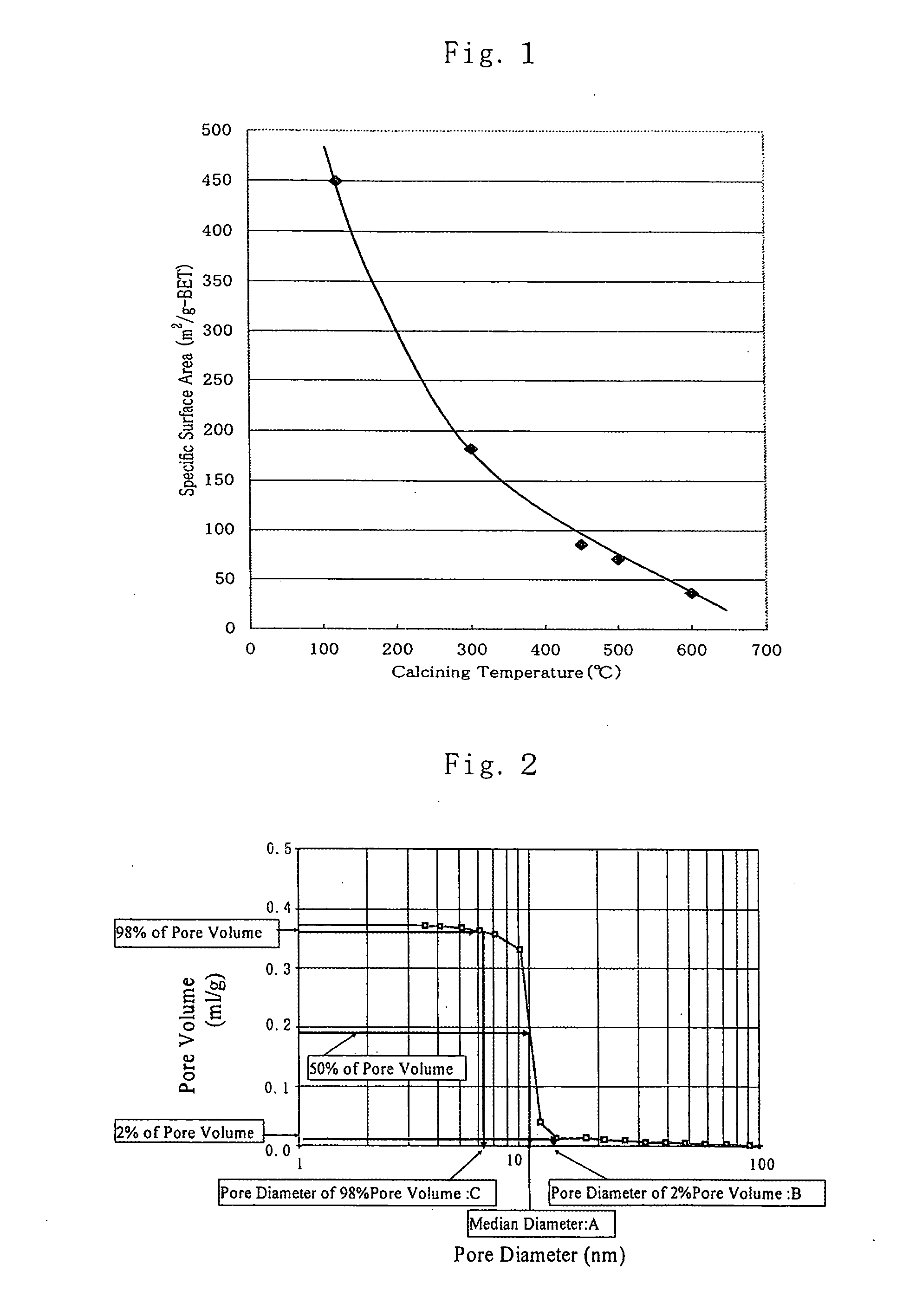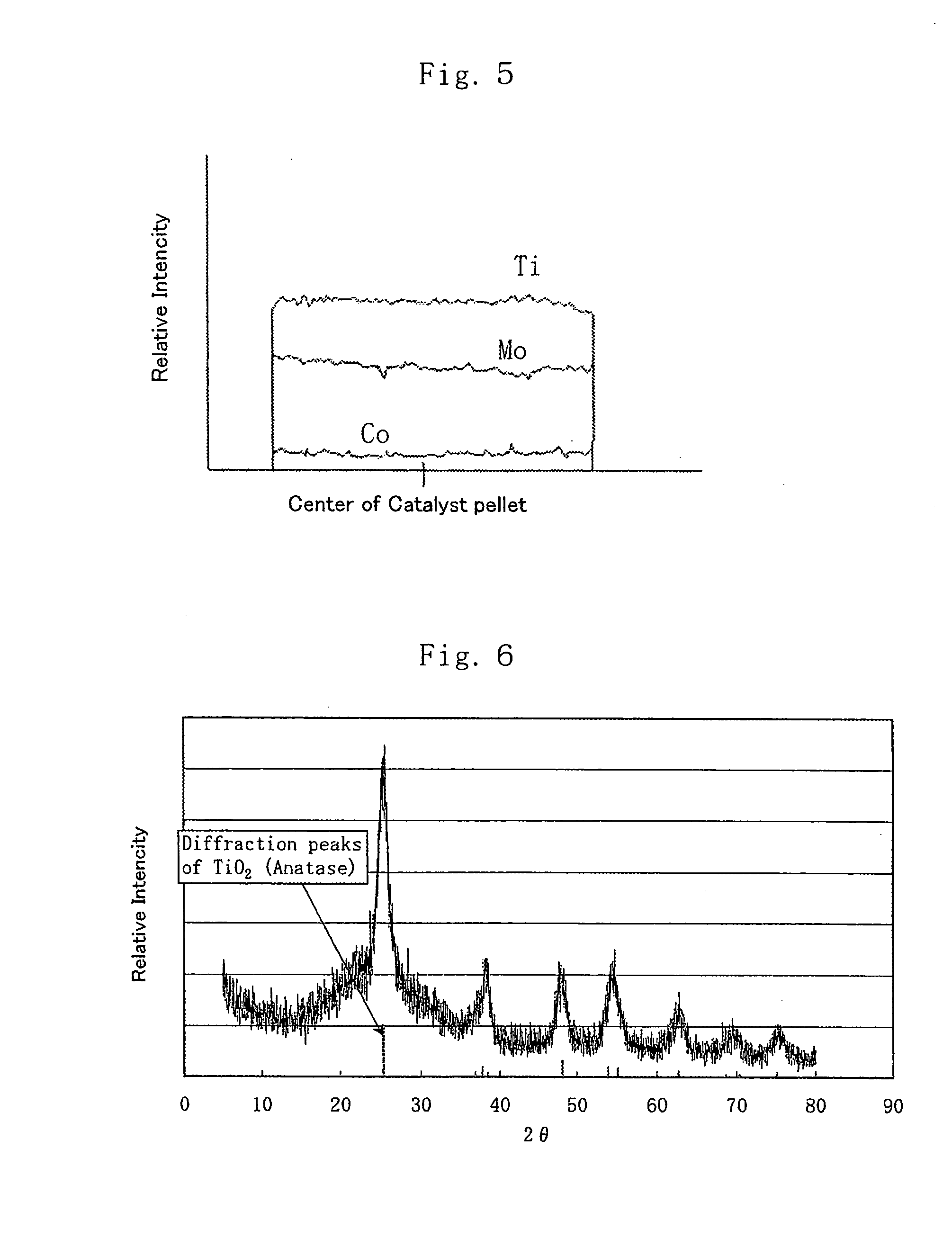However,
porous titanium oxide prepared by the aforementioned conventional methods generally shows
extremely poor heat stability and presents the problem of suffering a rapid loss in specific surface area and failing to maintain a large surface area when subjected to
calcination at high temperature or over a prolonged period of time.
What happens here is that the hydroxyl groups detach themselves from hydrous
titanium oxide and undergo condensation or
titanium oxide being formed undergoes the so-called
sintering thereby growing considerably in crystalline particles; for example, as shown in FIG. 1 which is a plot of the relationship between specific surface area and calcining temperature,
crystallization or
crystal transformation from amorphous to
anatase and
rutile takes place as the calcining temperature rises and, as a result, the specific surface area decreases rapidly which makes it difficult to maintain the specific surface area at a high level.
Under these circumstances, a catalyst carrier or a catalyst based on
titanium oxide, in
spite of its extremely
high activity for hydrotreating per unit specific surface area, cannot maintain a large specific surface area at high temperature because of its poor heat stability nor manifest a sufficient performance as a catalyst and, unlike catalyst carriers or catalysts based on
alumina or silica, has never been utilized commercially.
Where
titanium oxide is intended for use as an
alkylation catalyst, a high-temperature heat treatment is necessary in order to provide
titanium oxide with properties of a superstrong acid; but deteriorating heat stability and diminishing specific surface area cause a decrease m the
absolute amount of superstrong acid and the properties required for a catalyst could not be secured.
Where
titanium oxide was intended for use as a denitrogenation catalyst of exhaust gases, it could only be used with its specific surface area limited normally to a low range of 40-50 m.sup.2 / g because of its poor heat stability in
spite of its excellent denitrogenation activity per unit specific surface area.
Thus, the problems here were the necessity for using a large quantity of a given catalyst as well as narrowing of the range of use temperature of the catalyst caused by poor heat stability.
Moreover, where titanium oxide is used as a catalyst in the Fischer-Tropsch (FT) reaction, only titanium oxide with a small specific surface area was made available in
spite of its good abrasion resistance and it has not been possible to obtain a titanium oxide-based catalyst exhibiting satisfactory performance for this particular application.
Although the aforementioned technique involving addition of a
secondary component such as silica,
alumina and
phosphorus to titanium oxide can help to improve heat stability and give porous titanium oxide that is capable of maintaining a large surface area even after a high temperature heat treatment, the technique in question is not capable of controlling the pore size and
pore distribution of porous titanium oxide sharply and the scarcity of pore sizes optimal for the reaction in the catalyst has made it difficult to obtain sufficient performance in respect to such factors as reaction selectivity, activity and catalyst life.
This method can surely yield titanium oxide with a sharply controlled pore distribution; however, it was difficult by this method alone to prepare a titanium oxide catalyst which shows no decrease in specific surface area nor loss of activity as a result of heat history involving heat applied to
calcination in the catalyst preparation and reaction heat evolved in the
reaction system.
They cause
air pollution when discharged into air or they act as catalyst poisons when formed in the
decomposition or conversion reactions of the
hydrocarbon oils thereby lowering the efficiency of these reactions.
As a results, there rises a problem of an increased consumption of
hydrogen when
hydrocarbon oils are hydrorefined in the presence of a hydrotreating catalyst containing
nickel.
However, hydroprocessing by the use of the aforementioned conventional hydrotreating catalysts does not necessarily give sufficient performance in desulfurization and denitrogenation and it becomes necessary to conduct hydroprocessing under severer conditions in order to reduce the
sulfur components in gas oil to 50 ppm or less.
Or, it would be necessary to raise the
reaction temperature by 20.degree. C. or more and this would be done at a great sacrifice of the catalyst life.
These measures would forcibly incur a great deal of economic burden.
Moreover, it is difficult to remove
nitrogen components by hydroprocessing to the same extent as in the case of
sulfur components and any attempt to effect hydroprocessing to remove
nitrogen components at a
high rate would require excessive consumption of
hydrogen and this would necessitate installation of a new apparatus for producing
hydrogen at an
oil refinery where
excess hydrogen is barely available.
As described above, it is not possible to prepare a desulfurization catalyst of
high activity and this is for the following reason: in a hydrotreating catalyst consisting of the principal catalyst component
molybdenum and the
promoter component
cobalt and a catalyst carrier mainly composed of
alumina, the amount of
molybdenum is normally 25 wt % or less on the oxide basis and any attempt to increase
molybdenum any further would cause agglomeration of molybdenum on the catalyst carrier and this would prevent molybdenum from undergoing high dispersion and effectively manifesting catalytic performance and would additionally produce such adverse effects as blocking pores and decreasing surface area and pore volume thereby failing to exhibit a needed activity.
When the value of x in the aforementioned formulas is 0.1 or less, it becomes difficult to obtain a large specific surface area because of the growth of hydrous titanium oxide crystals and to attain a high dispersion of the catalyst components uniformly in
high concentration because of the decrease in the hydroxyl groups on the surface of hydrous titanium
oxide ion-exchangeable with the catalyst components.
Conversely, when x is 2.0 or more, the crystals of hydrous titanium oxide do not form which makes it impossible to obtain a
hydrosol or a hydrogel of hydrous titanium oxide in some cases; although the presence of a large number of hydroxyl groups
ion-exchangeable with the catalyst components is desirable from the viewpoint of supporting the catalyst components on a catalyst carrier, the
crystal particles of hydrous titanium oxide are small and amorphous when examined by X-
ray and the catalyst obtained after
drying and calcining has an inadequate pore structure or an inferior quality as a hydrotreating catalyst in other cases.
When y is less than 0.3 in the aforementioned formulas, hydrous titanium oxide is in the nearly dry condition and it is difficult to obtain a uniform and high dispersion of the catalyst components under such condition; moreover, when a solution containing the catalyst components is added to hydrous titanium oxide particles and stirred, the dispersion of the catalyst components progresses with difficulty because of agglomeration of the hydrous titanium oxide particles and it is difficult to obtain a uniform and high dispersion in this case.
As a result, a uniform and high dispersion is not possible to attain when the catalyst components need to be supported on titanium oxide in
high concentration and the catalyst components form an
agglomerate or a lump with the
resultant low catalytic activity.
Conversely, when y is in excess of 40, the amount of
free water that is not
structural water of hydrous titanium oxide becomes excessive and hydrous titanium oxide cannot be molded or, even if molded, the molded form becomes difficult to maintain.
Moreover, those hydroxyl groups which are near the portions bonded to anions or cations are subject to the influence of steric hindrance of anions or cations and bond with difficulty to the hydroxyl groups on the surface of other hydrous titanium oxide particles.
When the amount of the principal catalyst elements molybdenum (Mo) and / or
tungsten (W) supported on a catalyst carrier is less than 15 wt %, it is not possible to obtain the desired hydrotreating activity against
hydrocarbon oils.
 Login to View More
Login to View More 


